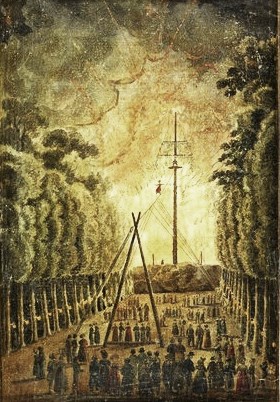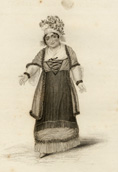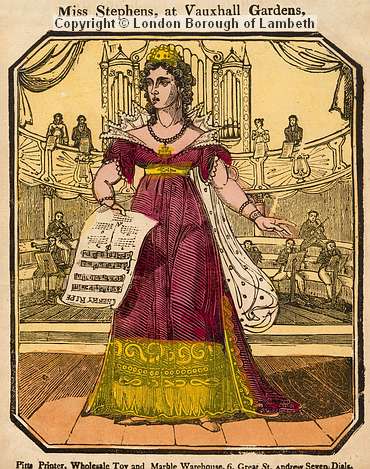Vauxhall Gardens: A History
David Coke & Alan Borg
The Vauxhall Pleasure Gardens is one of the places I’d love to slip back in time to visit, just to catch a glimpse of what it was like. After recently splurging to buy this lovely coffee-table book, I thought it might make a wonderful subject for a new blog series. But do buy the book too, if you can! The photos are fabulous!
Madame Saqui
Marguerite-Antoinette Lalanne came from an acrobatic family performing first at provincial fairs in France, and then at the fashionable Tivoli Gardens (‘The Paris Vauxhall’). Madame Saqui, as she was after her marriage, became so popular in France that Napoleon arranged for her to perform for his army, after which she had her coach painted with an imperial eagle.
Once the War with France had definitively come to an end, Vauxhall proprietors George Rogers Barrett and Jonathan Tyers Barrett were determined to persuade her to come to England to perform at Vauxhall. Her first performance, however, was at Covent Garden Theatre. See the print below “of her descending from the balcony on a tight rope, brandishing two large flags, as the men in the audience look up her skirt with telescopes. The caption reads: ‘A Wonderful THING from PARIS… or Madame SACCHI gratifying John Bulls curiosity, at Covent Garden Theatre, April 1816.’
Prior to the opening of the 1816 Vauxhall Season on 3 June, the advertisements included:
At the end of the first Act Mme and Messrs Sachi will go through a variety of surprising evolutions on the Tight Ropse… at the conclusion of the concert… fireworks… when Madame Sachi, in the midst of a brilliant display of Chinese fire, will perform her astonishing Ascension, as exhibited in the Gardens of Tivoli in Paris. Admission to the Gardens is lowered from 4s to 3s 6d.
The weather was perfect and the crowds flocked to catch a glimpse of the new attraction. The enormous success of the evening led to announcement that Madame Saqui’s troupe would perform every night until further notice. As they did, virtually every night of every season until 1820.
In her first year at Vauxhall, on the birthday of the Prince Regent, Madame Saqui exhibited her ‘grandest Feat which she had the honor of performing before the Sovereigns of Europe two years since, at Paris’—no doubt one of her spectacular ascents… [In 1819], instead of ascending from the ground, she suddenly appeared in the centre of a blazing star, 60 feet above the heads of the astonished crowd; from this she descended amidst a shower of fire accompanied by martial music. Then she turned round, ran back up the rope to the fiery star, only to be lost to view in a new barrage of fireworks. She also continued to perform with her daughter Adèle, the pair dancing an allemande on two or three ropes.
Madame Saqui left Vauxhall after the close of the season in 1820 to do other things, eventually retiring and falling on hard times. She did come out of retirement at the age of seventy-five, performing at the Hippodrome. A correspondent to L’Intermédiare des chercheurs et des curieux said:
When I was a child, I saw her dance on the tightrope at the Hippodrome; she was seventy-five. It was a pitiful sight to see this decrepit figure in a pink costume, her face the color of faded parchment surmounted by a grotesque diadem. She gained in my childhood memory as an unforgettable image of the evil diary Carabosse.
Musicians
One of the characteristics of many Vauxhall performers long service. “It was not unusual for musicians, including singers, to work each season in the gardens for at least twenty years, and some served for much longer: the kettledrummer Jacob Nelson held the record at fifty years…”
James Hook, composer and organist, was a fixture at the park from 1772-1821, composing “over two thousand songs and at least twenty organ concertos.”
William Parke, an oboist who joined Vauxhall with his brother John in 1776, composed numerous songs, concertos and other pieces, and also wrote Musical Memoires, which is full of information about the music at Vauxhall.
Strolling Players were the Savoyards , who played French and Venetian ballads in groups of four or five throughout the gardens following the main concert in the Orchestra, on instruments that included flutes and cymbals. The Pandeans (although some considered them to be the same as the Savoyards) played on pan-pipes. “The Duchess of Devonshire is known to have preferred the Pandeans…”
Charles Taylor received £290 in 1812. He
…was one of the longest-serving and most popular Vauxhall singers, especially noted for his comic songs. He first appeared in the gardens in 1794, returning regularly thereafter. He made the speech on the last night of the season several times and, unusually for a vocalist, rose to become Director of Music in 1822.
Mrs. Bland first appeared in 1790, retiring in 1823.
Described as ‘the sweet-voiced, dumpy little ballad singer’, she was said to have ‘refused an offer [for the 1789 season] of the Vauxhall Managers, to the tune of one hundred and sixty guineas.’ Her voice was ideally suited to the countless ballads that Hook and others wrote for her. Sometimes these demanded special effects—in June 1818, for example, she sang a new song by Parke, which was echoed in a distant part of the gardens by a bugle-horn.
Catherine (Kitty) Stephens, an actress and soprano, married the 5th Earl of Essex in 1838.
Charles Dignum first appeared in 1794, but became notable at Vauxhall during the first two decades of the 19th century. “He was well-known for his duets with Mrs Bland, especially Long Time I’ve Courted You, Miss, a dialogue between a shy sailor and a flirtatious lady.
John Braham, a popular operatic tenor, made his first appearance at Vauxhall as a boy soprano in 1787, “returning as an established star for the season of 1826, for the enormous fee of 800 guineas.”
Miss Feron (Fearon), known for her imitative talent, performed “a new comic song by Parke called The Romp or the Great Catalani, in which she used her powers of mimicry to parody the famous Italian soprano.” This act became so popular that it was repeated often and Parke writes:
…The recitative which introduces the air, ending with the words Great Catalini, it became necessary, in order to make the music accord with the poetry, to repeat a part of the last word, by which it read thus: Great Cat, Great Catalani. This, I was informed, gave umbrage to the lady, who, having perhaps an aversion to the feline race, said that she liked the song very well, with the exception of the Great Cat in it.”
Comic Songs
Parke’s Great Catalani was an early example of the double-entendre, that came to dominate the music hall… The words of many of these songs were published and sold at the gardens, so that the public came to know them by heart and to glamour for their repeated performance.
Susana’s Vauxhall Blog Post Series
- Vauxhall Gardens: A History
- Vauxhall Gardens: Jonathan Tyers—“The Master Builder of Delight”
- Vauxhall Gardens: A New Direction
- Vauxhall Gardens: The Orchestra and the Supper-Boxes
- Vauxhall Gardens: The Organ, the Turkish Tent, and the Rotunda
- Vauxhall Gardens: Three Piazzas of Supper-Boxes
- Vauxhall Gardens: “whither every body must go or appear a sort of Monster in polite Company”
- Vauxhall Gardens: The Competition
- Vauxhall Gardens: The Artwork, Part I
- Vauxhall Gardens: The Artwork, Part II
- Vauxhall Gardens: The Music, 1732-1859
- Vauxhall Gardens: The Business Side
- Vauxhall Gardens: Developments from 1751-1786
- Vauxhall Gardens: Thomas Rowlandson’s Painting (1785)
- Vauxhall Gardens: The Third Generation of the Tyers Family and the Jubilee of 1786
- Vauxhall Gardens: An Era of Change (1786-1822), Part I
- Vauxhall Gardens: An Era of Change (1786-1822), Part II
- Vauxhall Gardens: An Era of Change (1786-1822), Part III
- Vauxhall Gardens: The Final Years, Part I
- Vauxhall Gardens: The Final Years, Part II
- Vauxhall Gardens: The Final Years, Part III
- Vauxhall Gardens: The Final Years, Part IV
- Vauxhall Gardens: Farewell, for ever






Vauxhall Gardens was an amazing piece of history.
LikeLike